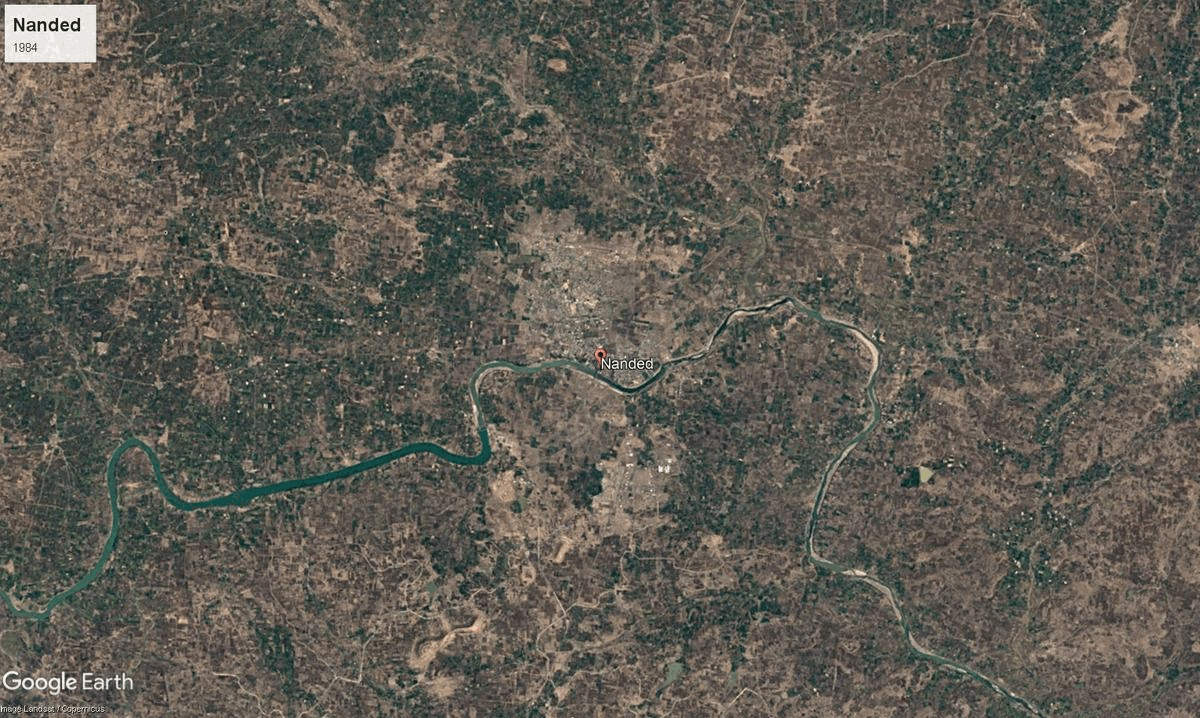Nanded

10,528 sq. km
~36.10 lakh (2019)
937 (2011)
~ ₹37,932 crore (2019)
~ ₹1.05 lakh (2019)
Nanded is set on the banks of the Godavari in eastern Marathwada. The district’s name, rooted in ltegends of Shiva and his bull Nandi resting evolved into “Nanded.” Archaeological records and historic inscriptions refer to it as Nandigrama and Nanditata. Its history stretches back to rule by the Nandas, who held sway in the 4th–5th centuries BCE, followed by the Mauryas under Ashoka, later the Satavahanas, Rashtrakutas, and the Delhi Sultanate. Nanded entered the Nizam’s Hyderabad State in 1725, and became part of the Indian Union in 1948 before joining Maharashtra in 1960.
Nanded is located on the banks of the Godavari River in west-central India. Physiographically, the district can be divided into 2 major parts, the hilly region on the North and North East and the low-lying area on the banks of the Godavari, Manjra, Manyad, Penganga. In general, the district's natural landscape features undulating hills in the north and fertile valleys carved by the rivers The physiography supports a mosaic of forests, rich wildlife, and agricultural lands, while hot springs at Unkeshwar add to its geographic allure.
Historically, Nanded was ruled by the Satavahanas, Vakatakas, Chalukyas, Rashtrakutas, Yadavas, Delhi Sultanate, Bahmanis, Barid Shahis, Nizam Shahis, Mughals, Marathas, and Nizams of Hyderabad before becoming part of independent India. Nanded has been mentioned in historical records dating back to the 1st century, . Upon the reorganization of states in 1956, the district came to comprise six talukas. Today, Nanded comprises 16 talukas: Ardhapur, Bhokar, Biloli, Deglur, Dharmabad, Hadgaon, Himayatnagar, Kandhar, Kinwat, Loha, Mahur, Mudkhed, Mukhed, Naigaon (Khairgaon), Nanded, and Umri.
Culturally, Nanded is famed as a religious hub—above all as the place where Guru Gobind Singh, the tenth Sikh Guru, spent his final days and declared the Guru Granth Sahib as the eternal Guru, transforming the city into a sacred site for Sikhs worldwide. The Hazur Sahib Gurdwara, one of the five Panj Takhts, draws millions of pilgrims every year. The district is a melting pot of faiths, with Vedic ghats, ancient temples like Mahur’s Renuka Devi Shaktipeeth, and Kandhar Fort, juxtaposed with vibrant Sufi, Jain, and Buddhist traditions. Nanded gave birth to renowned Marathi poet-saints, and has long been a center for pilgrimage, scholarship, and regional arts. Nanded Fort on the Godavari River, the Siddheshwar Temple in Hottal, Unkeshwar Hot Springs, Kaleshwar Temple, and Sahastrakund Waterfall, makes Nanded a blend of religious significance and natural beauty.
Nanded's economy is predominantly reliant on the agrarian sector. Crops grown around Nanded include cotton, bananas, sugarcane, mangoes, soya beans, sweet limes, Grapes, Papaya, and sorghum (jawar). It has a Regional Cotton Research Center to support its Cotton-growing industry. Tourism also plays a crucial role in Nanded as it is supported by 10 million annual visitors who are mostly religious pilgrims. The district also benefits from Industrial Estates located in Nanded, Dharmabad, Loha, Degloor, Kinwat, and Krushnoor (SEZ).
